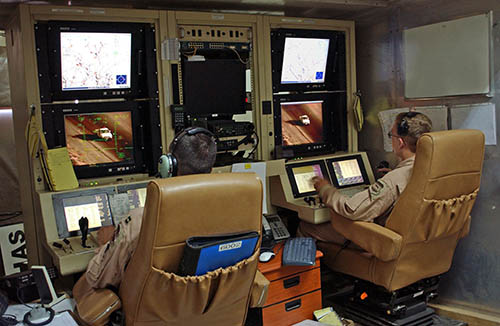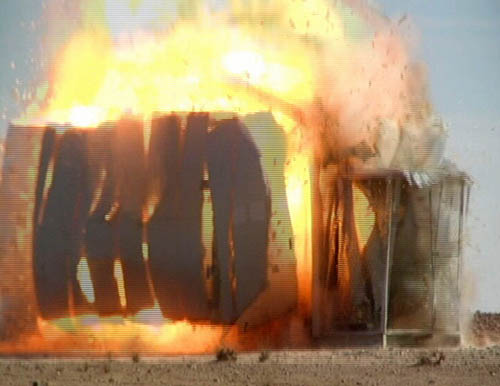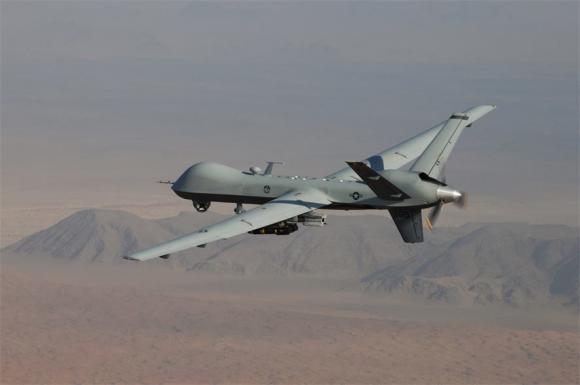The RQ-1 'Predator' and its successor MQ-9 'Reaper' (also known as Predator B) I'm Aircraft with Remote Piloting (APR, more commonly called "drones") produced by General Atomics of San Diego, California, and employed in surveillance missions, reconnaissance, armed reconnaissance and interdiction or ground attack (especially in "Hunter Killer" and "Targeting Leader" operations ).
The APR is remotely piloted by 2 operators, pilot and observer / gunsmith, in a UAV ground control station that can be set up in a trailer of the approximate dimensions of 10 mt. In Ground Station are housed a console for piloting and one for the payload of the drone, three Boeing consoles 'data exploitation and mission planning' and two radar 'synthetic openings' TESAR stations produced by Northrop Grumman connected to a satellite.
The aircraft have a length of 8,22 mt and a wingspan 14,8 mt, for the 'Predator' model, and of 11 mt with 20 mt wingspan for the 'Reaper' model and can take off from tracks of a minimum length of 600 mt . They feature synthetic aperture radar (in many Lynx SAR versions), Versatron / Wescam electro-optical Skyball Gimbal, conventional and forward-looking infrared (FLIR) cameras with 6 visual fields ranging between 19 mm and 560 millimeters.
 All images detected by the drone can be displayed in real time all over the world via L3 satellite connection. Both configurations are low-wing, one with inverted V fletching, the other with a top V fletching integrated with a ventral fin. Both versions are powered by turboprop engines.
All images detected by the drone can be displayed in real time all over the world via L3 satellite connection. Both configurations are low-wing, one with inverted V fletching, the other with a top V fletching integrated with a ventral fin. Both versions are powered by turboprop engines.
The medium-altitude RQ-1 is equipped with a Rotax 912 (or 914) 4 cylinder engine with 100 / 115 CV power. It can reach a maximum speed of 217 km / h, a tangency of 7.800 mt and has a range of 24 flight hours at 926 km from the take-off base.
Its successor, the MQ-9, has been improved to achieve greater tangency and double the payload: it features a Honeywell TP331-10T engine with 712 kW power that allows it to reach a maximum speed 482 km / h. It has an autonomy 14-28 hours (14 if fully loaded). The service quota is estimated at 7.500 and the tangible reachability is 15.000 m.
The arming of drones includes AGM-114 semi-laser guided antitank missiles Hellfire from 110lb and laser guided bombs Paveway GBU-12 or EGBU-12 or GBU-38 JDAM from 500 lb. The MQ-9 Reaper has reached a payload of more than 3000lb which allows it to transport up to four missiles between the lift and the 6 Hellfire II and two laser-guided bombs Paveway.
Drones are mainly used to eliminate targets such as bunkers, vehicles and other sensitive targets; if necessary to bring interdiction fire in support of ground forces.
The first operational use of an RQ-1 as a reconnaissance took place in Bosnia in the 1995 during the NATO operation Deliberate Force and continued operations Enduring Freedom in Afghanistan (2001) and Iraqi Freedom in Iraq (2003). The launch of a missile is tested in the 2001 Hellfire-C at the USAF air base in Nellis, Nevada. The following year a Predator leads the first mission Hunter-killer eliminating with a missile Hellfire a civilian vehicle on which terrorists had been identified in Yemen.
 The Predator B (MQ-9) was first used in the 2005 in the Balkan theater and has been deployed for precision attacks in Afghanistan since the 2007 in Iraq since the April of 2008. Drones of both models are in force in the United States aircraft (more than 12 squadrons).
The Predator B (MQ-9) was first used in the 2005 in the Balkan theater and has been deployed for precision attacks in Afghanistan since the 2007 in Iraq since the April of 2008. Drones of both models are in force in the United States aircraft (more than 12 squadrons).
MQ-9 are used in France (Escadron de drones 1 / 33 Belfort), in Great Britain (Sqd. No. 13 and 39), in Italy (6 appliances in the 32 'Stormo), in Spain (No. 47 Grupo Mixto ), The Netherlands, Turkey and the United Arab Emirates. The US Air Force fleet of remotely piloted aircraft, the largest in the world, currently has 175 "Reaper" and 150 "Predator".
The British RAF is making extensive use of Reaper against ISIS in theOperation Shader for armed reconnaissance and in support of the allied ground forces in Syria and Iraq, while the French Armée de L'Air is using the Reaper to monitor the area of the so-called G5 (Mauritania, Mali, Niger, Chad and Burkina Faso) to internal operation Barkhane.
The USAF recently obtained permission from the Italian government to have its drones take off from the Sigonella base for missions of a 'defensive' nature in Libya and North Africa within the Anti-ISIS effort of the international coalition. The Sigonella base, in Sicily, belongs to the Military Aeronautics and hosts an area of domain of the US Navy: the Naval Air Station Sigonella (NASSIG). A little further than 1000 km from the Libyan coasts, Sigonella would be a strategic launch position for future missions against Daesh in Libya.
The Ministry of Defense has announced that the missions of the American drones will have to be examined and received the permission of the Italian general staff from time to time.
"The use of the Sigonella base by the Americans will be discussed and authorized from time to time, in line with the foreign and defense policy lines and with the Italian strategy that the government has repeatedly explained to parliament" - he declared the Minister of Defense Roberta Pinotti.
(photo: US Air Force, Iraqi Air Force, Wikicommon)












